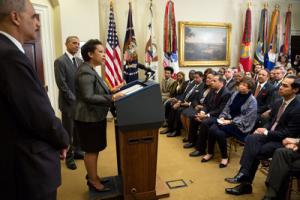San Bernardino attacksLoretta Lynch: No evidence San Bernardino shooters part of a cell
Some U.S. media reports said one of the San Bernardino shooters, Syed Rizwan Farook, may have been plotting an earlier attack in California with someone else, possibly as early as 2012. U.S. attorney general, Loretta Lynch, on a visit to London today (Wednesday), said, however, that there is no evidence yet that Farook and his wife had planned any other attacks or were part of a wider conspiracy.

Loretta Lynch with press at announcement // Source: whitehouse.gov
Some U.S. media reports said one of the San Bernardino shooters, Syed Rizwan Farook, may have been plotting an earlier attack in California with someone else, possibly as early as 2012.
Al Jazeera reports that U.S. attorney general, Loretta Lynch, on a visit to London today (Wednesday), said, however, that there is no evidence yet that Farook and his wife had planned any other attacks or were part of a wider conspiracy.
Lynch said that “At this point in time, we do not have an indication that these two people were part of a larger cell. We do not have an indication that they were planning specific things beyond this attack, although that information is still evolving.”
She added: “We have done over 300 interviews of witnesses, individuals who have some connection, any connection, to these two killers. A number of locations have been searched, a number of materials have been taken in and are being reviewed and analyzed.
“We are trying to learn everything we can about these two individuals, as individuals and as a couple, to determine why they chose that location, that event, that particular place to vent their rage. But at this point, [there is] no indication they were part of a larger cell or larger plot.”
The assault rifles used by Farook and his wife, Tashfeen Malik, are believed to have been bought by Enrique Marquez, a childhood friend of Farook, who has been questioned but not named as a suspect.
Lynch confirmed that the radicalization of the couple had been going on for some time, but added: “It’s really too early to tell at this point what was the genesis of it for either of them.”
She noted that about seventy jihadists had travelled from the United States to Syria to join ISIS, but said that the greater threat in the United States was posed by individuals radicalized by the material disseminated online by ISIS.
“We’ve shifted from a time where we have had the orchestrated, well-planned, large-scale 9/11 attacks of al-Qaida, though al-Qaeda is still a relevant terrorist organization and in many ways trying to remain relevant,” Lynch said.
“We have shifted to the smaller, more low-tech attacks and what we see [is] a lot of groups like ISIL using social media, using social propaganda seeking to broadcast their message in the hopes that it will resonate with people in the U.S. That has been their greater focus in the U.S.
“Their hope [is] that some individual, lost, unmoored, [for] whatever reason, drawn to a violent ideology, will connect with theirs and will then act on behalf of that ideology.”
